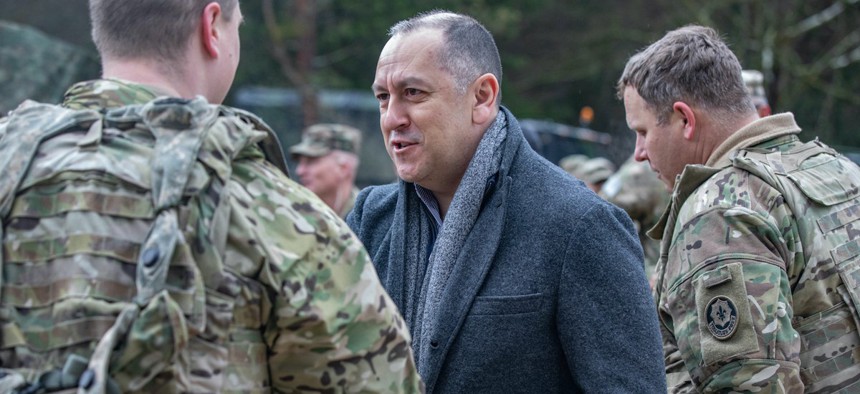
Under Secretary of the Army Gabe Camarillo, visits U.S. Army soldiers in Hohenfels, Germany, Feb. 1, 2023. U.S. Army / Staff Sgt. Ashley Low
Army announces plan to help spread commercial drones across infantry units
Army also hopes ordering more Coyote drone interceptors will eventually drive down cost.
HUNTSVILLE — Average Army infantry units will find it easier to get small commercial drones thanks to a new Army effort and may one day get a wider range of counter-drone equipment, Army leaders said Tuesday at AUSA.
“We recognize that some of our lower level units needed some ability to start experimenting with small UAVs,” Army Under Secretary Gabe Camarillo said.
The Army last week requested $25 million in its unfunded priorities list to field commercial drones for infantry brigade combat teams, in addition to multiple other requests for various drone and robotic systems.
Once approved by Congress, that money would be managed under a spending category called operation and maintenance funding, Army acquisition head Doug Bush said.
Funds budgeted to this category more typically go into activities like training and maintenance of equipment. The rules surrounding them are therefore “more flexible,” in terms of oversight, said Mark Cancian, a senior advisor at the Center for Strategic and International Studies.
Funds in operational and maintenance accounts can be disbursed at the discretion of unit commanders, although it is unclear to what degree the Army will push those decisions down the chain of command.
Cancian said the designation made sense for buying small, inexpensive drones. Operations and maintenance funds allow the process to go faster and be handled at lower levels compared to other forms of Army acquisition, Cancian said.
Army procurement processes are often expensive and years long events, such as the recently canceled Army program for the Future Attack Reconnaissance Aircraft.
Still, Cancian cautioned that the Army must be careful not to “abuse the authority,” as doing so could invite Congress to restrict its use in the future.
The drones will also be specifically acquired via “common hardware systems,” contracts, a category more typically reserved for rugged laptops or routers, said Camarillo.
“We're using that same contract vehicle as a mechanism to allow units to directly procure [drones]” he said.
The hope is that drones will be “inexpensive enough for units to truly experiment with,” said Bush.
Commanders do not necessarily have to acquire drones, Bush said, but providing the money creates a path for commanders “who want to emphasize this kind of thing to do it in an easier way than relying on procurement dollars.”
Army Chief of Staff Gen. Randy George has pushed for the Army to begin testing experimental equipment by fielding it directly to units in a program he has dubbed “transforming in contact.”
Drones must be off the Blue UAS list, said Camarillo, a list of drone manufacturers that the Defense Department has determined presents no security risk.
In 2018, the Defense Department banned military units from buying drones from China, one of the largest manufacturers of commercial drones. In 2022, the Pentagon placed prominent drone maker DJI on a blacklist over alleged ties to the Chinese military.
Drones on the Blue UAS list, however, can cost many times the price of Chinese commercial drones, meaning that the $25 million requested will stretch to fewer drones than what everyday consumers could buy with that money.
The Army is also eager to find more and cheaper solutions for taking out the drones that have attacked military bases in the Middle East, including a January attack that killed three soldiers.
The Army is seeking $117 million worth of Coyote drone interceptors in the 2025 fiscal year budget, which Army leaders have praised as effective against drone threats.
The Coyote, though, costs around $125,000 per unit, or several times more than the cost of the Shahed-136, a widely used Iranian loitering munition that may cost as little as $48,800.
The Army expects prices to eventually go down for Coyotes, thanks to economies of scale. “I think buying additional procurement quantities of any particular type of interceptor will certainly help,” said Camarillo.
In the long term, the Army is also looking at other solutions that provide a better cost-to-kill ratio, said Bush, including directed energy weapons, Coyote variants that can take out multiple drones and Advanced Precision Kill Weapon System (APKWS) rockets, which have been used in Ukraine. Bush added that 30mm autocannon rounds are also under consideration.
Army Futures’ Command head Gen. James Rainey cautioned against taking the counter-drone defense in Ukraine or on U.S. bases in the Middle East as an exact model for future U.S. counter drone fieldings.
“We're currently watching static attrition warfare in the Ukraine — we don't fight that way,” said Rainey. U.S. forces, by contrast, place a premium on offensive operations that avoid grinding attritional warfare.
“I think our enemies would have a problem if they were trying to launch massive waves of UAVs while they were confronting aggressive offensive operations,” he said.
